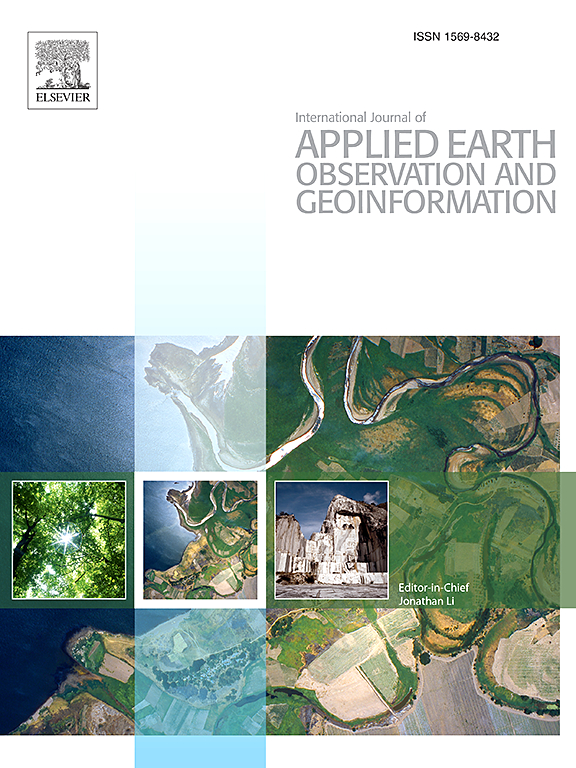Assessing differences in work intensity resilience to pandemic outbreaks using large-scale mobile phone data
IF 7.6
Q1 REMOTE SENSING
International journal of applied earth observation and geoinformation : ITC journal
Pub Date : 2025-02-01
DOI:10.1016/j.jag.2024.104343
引用次数: 0
Abstract
Pandemic outbreaks significantly disrupt human work activity, which is a crucial aspect of urban daily life, potentially causing reduced income or unemployment. These disruptions often vary across different population groups and regions. However, most existing studies focus on general human mobility patterns with limited attention specific to work activity, and conduct separate analyses on population groups and regions, overlooking intra-population differences across regions and inter-population variations within the same region. To this end, we first introduce the concept of work intensity to quantify the work activity. Using large-scale mobile phone data, we then estimate an individual’s work intensity, and characterize the changes in work intensity based on the concept of resilience, i.e., the ability to withstand and recover from a disaster. Finally, we propose a novel analytical framework that integrates both population groups and regions to assess differences in resilience. Herein, we take the pandemic outbreak in Beijing after the sudden relaxation of dynamic zero-COVID policy as a case study due to less policy intervention. Results reveal that females and younger people exhibit lower work intensity resilience, respectively. We also find significant regional differences and several negative features for resilience: short distance to city center, long home-to-work distance, high density of high-paying jobs, low road density, and high density of subway stations. By integrating both population group and region perspectives, we identify vulnerable population groups in specific regions. This integrated perspective can help design more targeted response and recovery strategies, and thereby promote health-related urban resilience and sustainability.
利用大规模移动电话数据评估工作强度对大流行病爆发的复原力差异
大流行病的爆发严重扰乱了人类的工作活动,这是城市日常生活的一个重要方面,可能导致收入减少或失业。这些破坏在不同的人口群体和地区往往有所不同。然而,大多数现有的研究集中于一般的人类流动模式,对工作活动的关注有限,并对人口群体和区域进行单独的分析,忽视了区域间人口内部的差异和同一区域内人口间的差异。为此,我们首先引入工作强度的概念来量化工作活动。利用大规模的移动电话数据,我们估计了一个人的工作强度,并根据弹性的概念描述了工作强度的变化,即承受和从灾难中恢复的能力。最后,我们提出了一个新的分析框架,将人口群体和地区结合起来评估恢复力的差异。本文以突然放松动态零冠政策后由于政策干预较少而导致的北京疫情为例进行研究。结果显示,女性和年轻人的工作强度弹性分别较低。我们还发现,弹性的区域差异显著,且存在几个负向特征:距离市中心较近、家到工作地点距离较长、高收入工作密度较高、道路密度较低、地铁站密度较高。通过整合人口群体和区域视角,我们确定了特定区域的弱势群体。这种综合视角有助于设计更有针对性的应对和恢复战略,从而促进与健康有关的城市复原力和可持续性。
本文章由计算机程序翻译,如有差异,请以英文原文为准。
求助全文
约1分钟内获得全文
求助全文
来源期刊

International journal of applied earth observation and geoinformation : ITC journal
Global and Planetary Change, Management, Monitoring, Policy and Law, Earth-Surface Processes, Computers in Earth Sciences
CiteScore
12.00
自引率
0.00%
发文量
0
审稿时长
77 days
期刊介绍:
The International Journal of Applied Earth Observation and Geoinformation publishes original papers that utilize earth observation data for natural resource and environmental inventory and management. These data primarily originate from remote sensing platforms, including satellites and aircraft, supplemented by surface and subsurface measurements. Addressing natural resources such as forests, agricultural land, soils, and water, as well as environmental concerns like biodiversity, land degradation, and hazards, the journal explores conceptual and data-driven approaches. It covers geoinformation themes like capturing, databasing, visualization, interpretation, data quality, and spatial uncertainty.
 求助内容:
求助内容: 应助结果提醒方式:
应助结果提醒方式:


